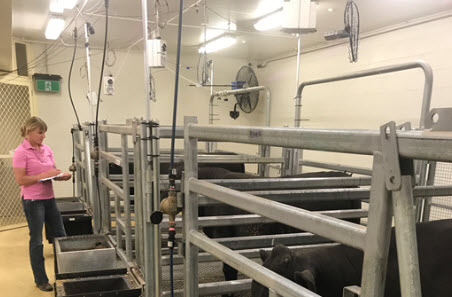How does heat load affect feedlot cattle?

The latest phase of an MLA research project, funded by grainfed levies in consultation with the Australian Lot Feeders’ Association, has revealed the metabolic impacts of a heat load event on feedlot cattle.
The project is being led by Dr Gene Wijffels from CSIRO along with Associate Professor John Gaughan and Dr Megan Sullivan from The University of Queensland (UQ). It has involved experiments using state of the art climate chambers at UQ Gatton’s Queensland Animal Science Precinct.
The goal of the experiments was to establish a repeatable model to induce excessive heat load in feedlot cattle, so that impacts on nutrition and management could be assessed and future trials could focus on maximising animal comfort. All trials were conducted under Animal Ethics approval of The University of Queensland.
Progress on the project
“We’re now able to understand what a heat load event does to an animal both on the outside and the inside of the body,” Dr Wijffels said.
The trials involved a strict cohort of black Angus steers at live weights of 600kg at 60 days on feed. These animals can be adversely impacted by high heat load in terms of physiological, behavioural and performance parameters.
“What we found was the usual physiological and behavioural changes that you see in feedlot cattle outside in a pen during a heat load event – increased respiration rate and rumen temperature, a massive drop in feed intake, increased water usage (drinking and head dunking), and depression,” Dr Wijffels said.
Initial findings
There was a 65% reduction in daily feed intake when cattle were exposed to high heat load. Feed intake before the heat event was 11kg/day and dropped to close to 5–6kg/day during the event.
Rumen temperatures were measured in real-time and saw a maximum of 42oC, compared to normal temperatures of 38–39oC.
“We also discovered the metabolic consequences, which included a large loss of carbon dioxide from the blood due to increased panting and drooling,” Dr Wijffels said.
“The cattle tend to go into a hypometabolic state, which means their metabolic rate declined. The liver and kidneys slow down and the result is that they retain urea and electrolytes such as salt.
“Energy metabolism is changed significantly. They became hypoglycaemic (low blood sugar levels) and it takes a long time to recover from this state.
“We found the cattle were hypoglycaemic for up to five days as a result of a heat event, and that they resorted to burning fat and ran out of blood glutamine,” Dr Wijffels said.
The trials also revealed major changes in circulating white blood cells, which made the cattle more vulnerable to viral, parasitic and bacterial infection.
“Even when heat is reduced, that doesn’t mean everything bounces back quickly – there’s a sustained recovery period that we’re still evaluating.
“Feed intake did not return to the pre-heat challenge levels. Even 10 days after being back to thermo-neutral conditions, feed intake only reached 80% of previous levels.
Next steps
Dr Wijffels said the results of the climate chamber trials had given the team confidence to move to the next stage of research, which will look at management and nutritional interventions.
“I would love to look at Senepol cattle in a similar trial to what we’ve done with the Angus steers, as it’s been suggested they have a high heat tolerance.
“Our next series of experiments is looking at a heat load ration and the timing of feeding this ration. We’ll have the first results of that work by August next year,” Dr Wijffels said.



